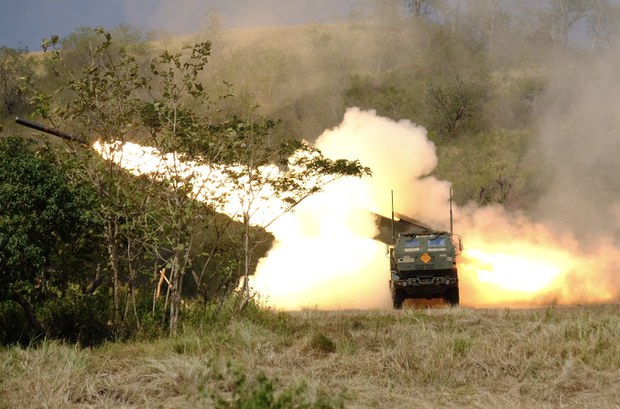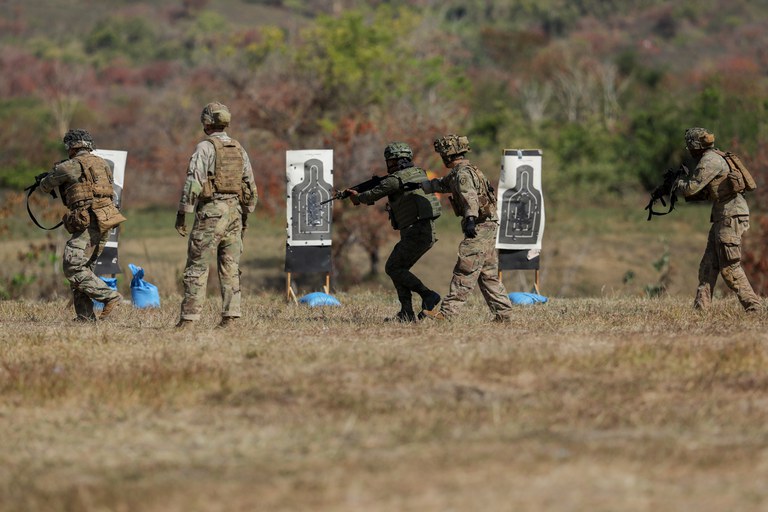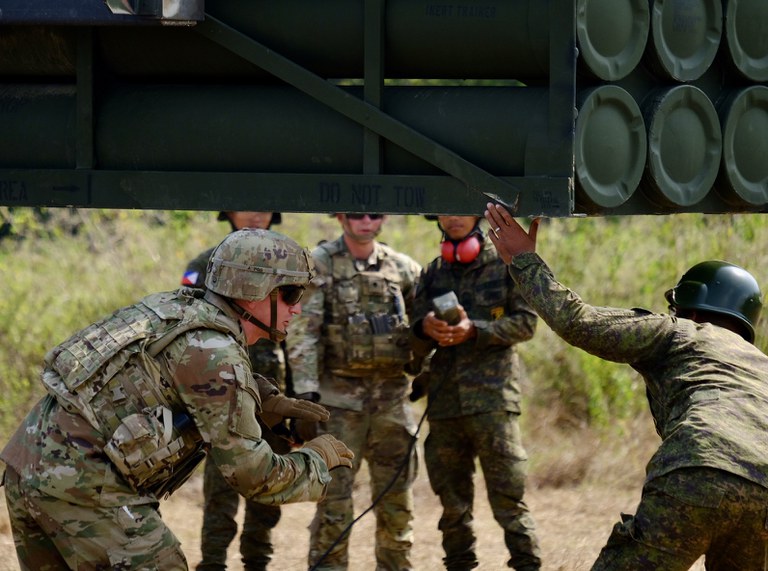Philippine, US armies in live-fire drills in northern Philippines
2023.03.31
Fort Magsaysay, Philippines
 A rocket is fired from a High Mobility Artillery Rocket System (HIMARS) during joint training exercises between the armies of the Philippines and the United States at Fort Magsaysay, in Nueva Ecija province, Philippines, March 31, 2023.
A rocket is fired from a High Mobility Artillery Rocket System (HIMARS) during joint training exercises between the armies of the Philippines and the United States at Fort Magsaysay, in Nueva Ecija province, Philippines, March 31, 2023.
Filipino army troops on Friday got their first taste of how to use advanced weapons systems, including a rocket system that can hit a target 80 kilometers (49.7 miles) away and a modern anti-tank system seen as key to the Philippine infantry’s modernization plan.
Under the searing heat of the sun, they were taking part in live-fire drills and demonstrations with their American counterparts at a military base in the northern Philippines.
A busload of selected journalists was escorted into the normally closed Fort Magsaysay, an army camp in Nueva Ecija province, for a day-long program to showcase the armament training under joint U.S.-Philippine exercises called “Salaknib,” a local term meaning “shield.”

Officially, the main purpose of the program is to “bolster interoperability between the two land forces,” though Fort Magsaysay is one of nine facilities where the Philippine government has granted the U.S. military access to build future facilities under an Enhanced Defense Cooperation Agreement.
Among the nine sites, four have yet to be named, although Philippine President Ferdinand Marcos Jr. this month said they would be “scattered around the Philippines,” despite persistent reports in the local press that they would be located in the northern island of Luzon, across the sea from Taiwan. Nueva Ecija is one of the provinces of Luzon, the most populous island in the Philippine archipelago.
The drills, which began on March 13 and go until April 4, are happening at a time when tensions are brewing in the Taiwan Strait. Filipino nationalist groups meanwhile have aired fears that the Philippines – a staunch U.S. ally in the Pacific – would be drawn into the conflict should American forces use the bases here to quickly aid Taiwan, if that island came under attack from mainland China.
Neither American nor Filipino military officials wanted to comment on these geopolitical matters Friday, but they acknowledged that the advanced High Mobility Artillery Rocket System (HIMARS) could be effective in stopping opposing forces from far away.
“HIMARS are highly usable advanced weapon systems in terms of the artillery, in the sense that a rocket artillery unit that’s wheeled instead of trucked, it gives you more mobility, it’s a little lighter, it gives you air mobility on certain fixed-wing platforms. It is a little bit more agile,” said Maj. Joe Roberts, an American operations officer.
“Today we demonstrated what it looks like to fire a HIMARS weapons system. Really in any combat situation, the HIMARS system is very useful.”
Lt. Col. Tar Cayton of the Philippine Army’s artillery regiment said the Filipinos appreciated the demonstration, which, she said, gave them an opportunity to try their hands on the new system. She said she hoped that part of the military’s modernization program to acquire HIMARS was on the top of the Philippine government’s list.

After the HIMARS demonstration, Filipino troops joined live-fire exercises using the AT-4 84-mm anti-tank weapon system, the first time that both sides used the weapon in training.
They carried out the drills during a day when the outdoor temperature in Nueva Ecija was as hot as 38 degrees Celsius (100.4 degrees Fahrenheit), and with high humidity to boot.
More than 3,000 Filipino and U.S. forces are training in the ongoing exercises.
It’s a prelude to the annual Balikatan war games, which this year will be the biggest-ever military drills so far involving 17,600 troops from both sides. Those drills will take place from April 11 to 28, during which the allies, for the first time, will conduct live-fire exercises at sea.








